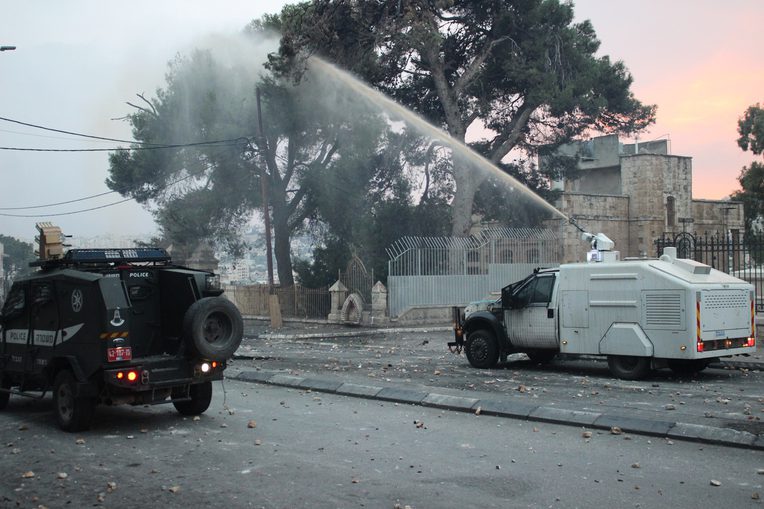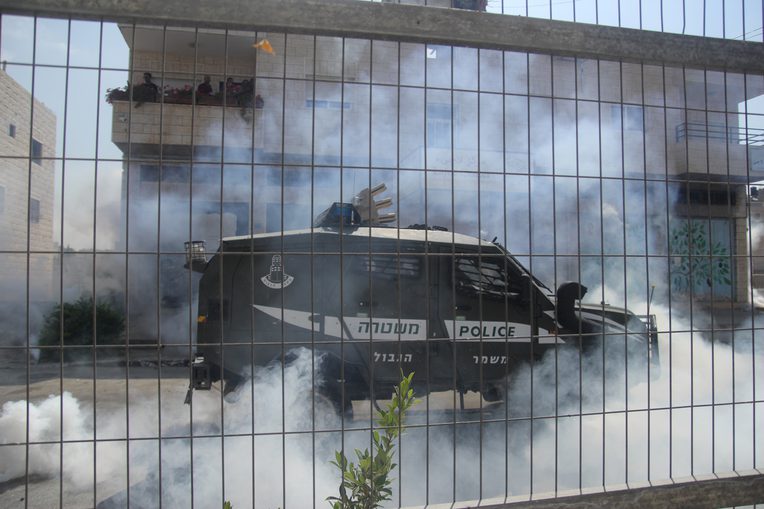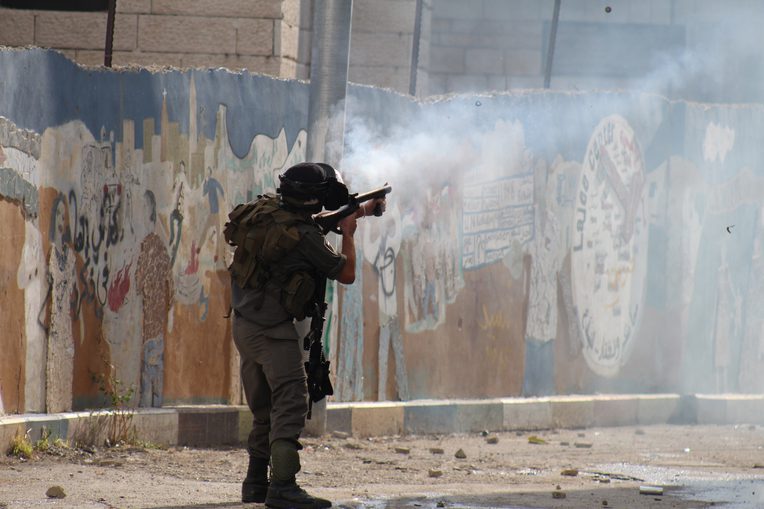Killing Space, Stealing Time: The Stink and Burn of Occupation
From the Series: Ecologies of War
From the Series: Ecologies of War

In the West Bank, the stink of militarized occupation sits at the intersection of attempts to denigrate places and people and outright threats to lives. It is difficult to codify the health effects of so-called less-lethal weapons as they are deployed over time, but these poisonous smells surely evacuate public space, steal time, and make a safe home impossible.
The common framing of Israeli occupation as one where the main dangers are, theoretically, bullets, bombs, and incarceration can make it difficult to recognize the interrelationship of an environmental condition like “waste siege” (Stamatopoulou-Robbins 2020)—an intensely sensed condition of military occupation and neoliberalism—with outright military threats. But in hot spots of resistance, smells are part of the infrastructure of occupation. Thinking through militarized ecologies presses us to reckon with how people live with militarism over many years.
Since 2005, Aida Refugee Camp has been surrounded on two and a half sides by al-jidar al-fasl al-ʿunsuri as activists call it, or Israel’s “racist apartheid wall.” The structure has intensified Israeli military violence, as Israeli contractors and soldiers have repressed Palestinian protest year after year (Bishara 2020). Building on Eleana Kim’s observations about infrastructures of war that can define the environment over a long term (Kim 2016), we can understand the wall and weapons used to maintain it as a dispersed infrastructure that produces an environment threatening to health and well-being in this community, even after the bullets stop flying. Indeed, as Kristen Simmons writes of another settler colonial context, “The atmosphere is increasingly a sphere to be weaponized.”
Israeli forces deploy skunk water in many places
of Palestinian protest. Odortec—the producer of skunk water—claims
it is organic and nontoxic, an ethical answer to protest suppression. But skunk water is chemically engineered to smell like dead bodies and sewage. Its smell adheres to streets and buildings for days, even weeks. In Aida, Israeli forces have sprayed it at homes and youth centers. Skunk water odiously renders dignified, cared-for places of everyday life or of protest (and in Aida the two are often one and the same) into unbearable ones. If, in their villages before 1948, the great-grandparents of Aida’s refugees had large families in part to work the land together—to plant grains or harvest olives—today a large extended family might utilize its collective resources (and a vast percentage of available water) to clean their house to rid it of this shit smell. This is one of the many ways the occupation wastes Palestinians’ time.

But there is a smell worse than skunk water. Tear gas can actually kill people. A Berkeley research team in concluded in 2017 that Aida was among the most tear gassed places on Earth. Soldiers shoot it either from a rifle-like weapon or in multiples from atop a jeep. Skillful protesters might hurl canisters quickly back toward the army while they spew their white spirals of gas. But tear gas forces indoors those not directly involved in protest. People are in the terrorized habit of rushing to shut their windows at the first acrid whiff of tear gas, because they know that when the Israeli army uses it, they use it in prodigious quantities. Noha Katamish, 45, died because a tear gas canister spun into her home in April 2014, and she could not escape its suffocating effects. Residents fear having an elder caught at home unable to close the windows fast enough.
One time, I was hanging out at a summer camp in a youth center in Aida when a child came up to me, her curly hair framing a perfect round face. “Amahl,” she said, “My eyes are burning.” Had she gotten sunblock in her eyes? I asked without thinking. No, she said, she had been playing in the dirt. Just stirring up the dirt had lifted tear gas dust and burned her. Tear gas steals fun.

We wonder what it does to the rooftop gardens that our community center and families have worked hard to establish together. It often seems best not to ask too many questions: How would we answer them? And to what land would these refugees turn if they lost these small patches they have cultivated?

The Berkeley study found that tear gas impacts mental and physical health. Among other symptoms it can cause loss of consciousness, miscarriage, breathing difficulties (including asthma), and headaches. A recent study about much shorter exposures to tear gas in Portland, Oregon, following police repression of Black Lives Matter protests confirms many of these negative effects.
If the smells of military occupation make homes insecure and evacuate public spaces, what is left? These smells instantiate the ways that military occupation permeates communities like Aida. What haunts me most these days are the hints of long-term effects from this stressful and toxic atmosphere. In Gaza, military siege led the UN to predict in 2012 that Gaza would be unlivable by 2020. So what can we say about the enduring effects of Israel’s militarized ecology in smaller places like Aida in the West Bank? Circumstances in Gaza—in terms of water access, bombings, and so much more—are uniquely dire. But I worry about Aida too: the number of young women who have unusual health problems; the middle-aged people with cancers. I think of how my friends in Aida look to the future differently than I do, living in a leafy part of New England. The wall, the tear gas, the jeeps, the skunk water: The multifaceted effects of ecologies of war may be difficult to characterize in small places where conflict seems to happen through outright violence, but residents know these ecologies kill space and steal time, too.
Bishara, Amahl. 2020. “An Ongoing Violence, a Sustained Resistance: Israel’s Racist Separation Wall at Aida Refugee Camp.” In Walling In and Walling Out: Why Are We Building New Barriers to Divide Us?, edited by Laura McAtackney and Randall H. McGuire, 85–107. New Mexico: University of New Mexico Press.
Kim, Eleana J. 2016. “Toward an Anthropology of Landmines: Rogue Infrastructure and Military Waste in the Korean DMZ.” Cultural Anthropology 31(2): 162–87.
Stamatopoulou-Robbins, Sophia. 2020. Waste Siege: The Life of Infrastructure in Palestine. Stanford, CA: Stanford University Press.